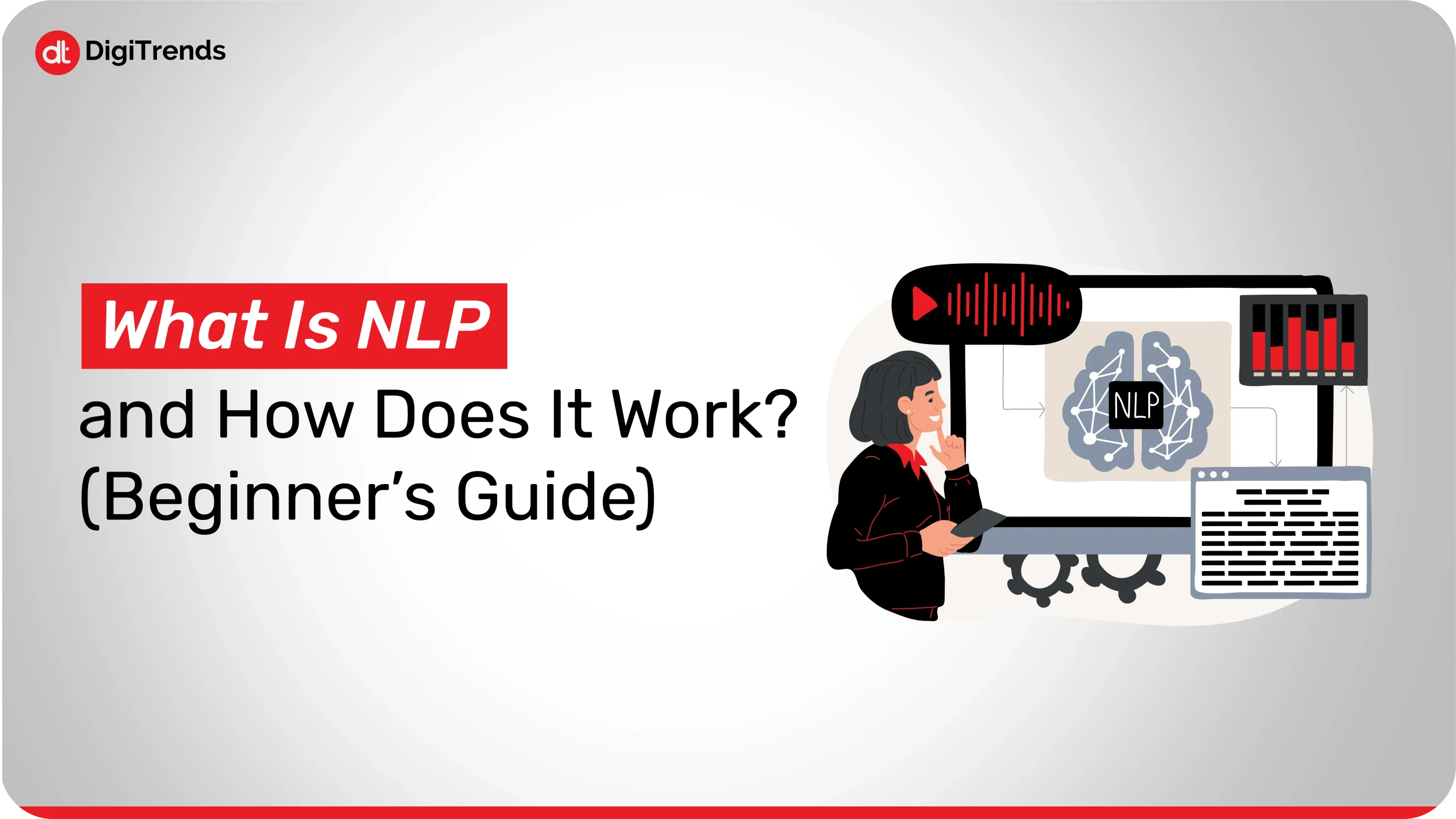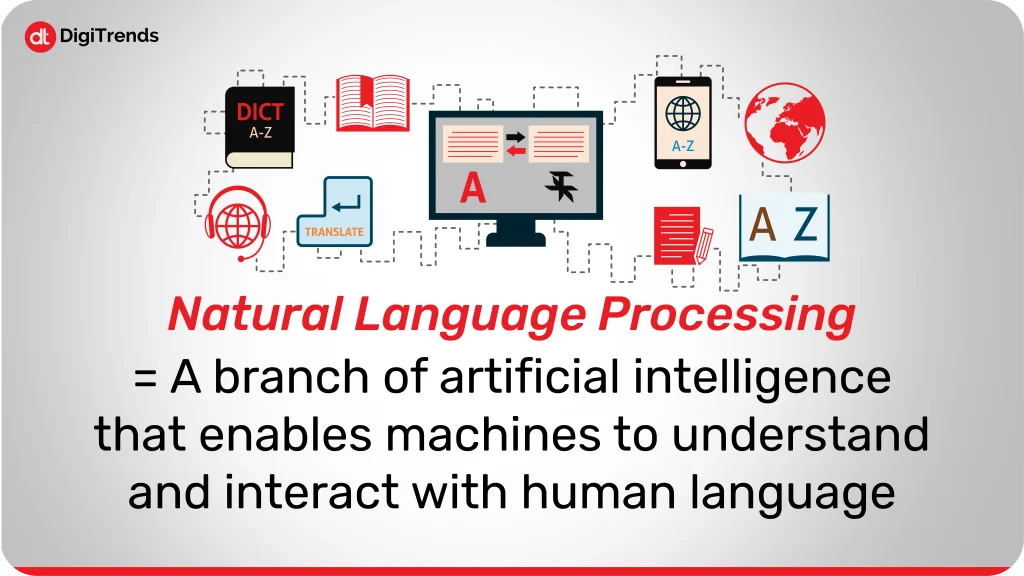
Inside DigiTrends’ Approach to Feature-Rich HCP Portal Development
Explore how DigiTrends approached HCP Portal Development with features like webinars, telemedicine, online CMEs, and more.
Continue Reading
NLP is a term that is used a lot nowadays, but what does it actually mean?
This is something you must have encountered in technical articles, business courses, and even personal development materials.
Sometimes it means natural language processing, other times it’s short for neuro-linguistic programming.
Same term, but both have different fields.
So before we dive into how NLP works, let’s get one thing clear. This blog focuses on natural language processing, a branch of artificial intelligence that enables machines to understand and interact with human language.
Whether it is voice assistants, chatbots, or even the auto-generated summaries, NLP is what helps computers read, write, and even talk in a manner that humans naturally talk in. According to research, the natural language processing industry is projected to reach USD 213.54 billion by 2035.
If you’ve ever wondered what NLP is, what NLP stands for, or how machines seem to understand context, tone, or intent, you’re in the right place.
We’ll break down the meaning of NLP, explore real-life examples, and walk through some common NLP techniques that support the apps you use every day.
Let’s start with the basics.

The full form of NLP is Natural Language Processing.
It is, in simple words, a domain that consists of a blend of computer science, linguistics, and machine learning. Its goal is to teach computers how to understand and respond to human language in a way that makes sense to humans.
But it is quite obvious that human language is messy. We usually use sarcasm, slang, typos, tone, and context that aren’t always easy to understand. Systems are not aware of the slang we use or the way we talk, hence, it can be a little difficult to interpret every prompt. We can also think of it like how different countries can’t always understand the slang of other countries, just like that, systems have their own language, and they can’t understand the way we communicate.
That’s where natural language processing steps in.
It helps machines translate the language into something they can also understand. Whether it’s a short text, a voice command, or a full-length article, NLP systems try to figure out what the user meant and what to do with that information.
So if you’ve ever asked Siri to set a reminder, seen Google suggest an email reply, or typed something into a chatbot that understood you, that’s NLP in action.
Now, you must be wondering how NLP works.
That’s exactly what we’ll talk about next.
Let’s break it down.
In simple words, natural language processing is all about changing the words we humans use into a form of language that can be easily understood by a computer that can interpret and react to it. That has several important steps, and each and everyone is responsible for solving a section of the language puzzle.
Here’s how it typically works:
The first step in NLP is to take up tasks. Let’s take the example of a chatbot. When we ask a question or put a prompt in the chatbot, it first accepts our input, which can be anything, including text, a voice, or a document.
After accepting the input, the second step is to clear up the prompt given by you, because the system needs to clean up the message before understanding it.
This usually includes steps like:
Tokenization: This means to break the sentences into small words or phrases
Lowercasing: This means making everything lowercase for consistency
Removing punctuation or stopwords: This means removing things like “and,” “the,” “is,” etc.
Stemming or Lemmatization: This means reducing words to their root forms (like “running” to “run”)
You can think of this like translating a messy sentence into a neat set of building blocks.
Now this is where the smart part comes.
The system employs NLP techniques such as machine learning, statistical models, or deep learning to analyze the phrases. It combines grammar, sentence structures, word relationships, and context. Instead of just recognizing words, it tries to figure out what the sentence actually means.
For example:
“Can you book a flight for tomorrow?”
The system identifies that the user wants an action, booking, and the subject is a flight for a specific time.
Once the meaning is clear, the system takes whatever action is needed to be taken. These actions include replying in a chatbot, starting a task in an app, or giving information from a database.
Some NLP systems also generate responses using natural language generation (NLG), which means the machine writes or speaks in a human-like way.
This might sound like it is a long process, but all of this happens in seconds, sometimes even less, and that is what makes NLP language processing so powerful because it’s not just reading words, it’s also trying to understand intent, meaning, and context, just like we do when we talk to each other.
Next, we’ll look at the most common NLP techniques that make all this possible.

Now that we’ve covered how NLP works, let’s look at the core techniques that actually make it happen.
These methods are used to break down, understand, and sometimes even generate human language. Whether you’re building a chatbot, an email classifier, or a search engine, these NLP techniques are at the heart of it.
This is step one in most NLP workflows. Tokenization splits text into smaller parts, usually words or subwords, so the system can analyze them more easily.
Example:
“I love NLP.” becomes [“I”, “love”, “NLP”, “.”]
This technique identifies the grammatical role of each word, noun, verb, adjective, etc. It helps the system understand sentence structure and context.
Example:
“Book a flight”, is “book” a noun or a verb? POS tagging helps figure that out.
NER finds and classifies proper names in text, like people, locations, brands, or dates.
If someone says “Schedule a meeting with Zara on Monday”, the system needs to recognize Zara as a person and Monday as a date.
This technique detects emotional tone, positive, negative, or neutral. It’s widely used in product reviews, customer support, and social media monitoring.’
Example:
“I love this app” = Positive
“This service is awful” = Negative
This digs into sentence grammar to find how words relate to each other. It helps NLP systems understand sentence structure beyond just word order.
This involves labeling text based on predefined categories, like tagging an email as spam or sorting a support ticket by topic.
Used heavily in content moderation, news feeds, and inbox management.
This is where things get powerful. Language models (like GPT or BERT) are trained on massive text datasets to predict and generate language. These models understand grammar, meaning, and context at a deeper level.
They power everything from auto-complete to full-on content generation.
These are just the basics, but they form the foundation of everything NLP does.
Whether you’re curious about NLP training, aiming to become an NLP practitioner, or just want to understand how your favorite apps talk back, these techniques are what make it all tick.
Now that you’ve got the basics down, let’s talk about where NLP shows up in everyday life.
You might not realize it, but you’re already using NLP-powered tools all the time
Here are some of the most common (and surprisingly smart) ways it’s working behind the scenes:
Siri, Alexa, Google Assistant, they all rely on NLP to understand your voice, figure out what you mean, and respond in a way that feels human.
When you say “Remind me to call mom at 6”, NLP processes that sentence, picks out the intent, time, and action, and turns it into a task.
Most modern chatbots use NLP to handle basic questions, solve problems, or route you to the right department.
Good ones can even recognize mood and urgency, which helps improve response quality.
Spam detection, promotional tabs, and smart replies, all driven by NLP.
The system scans email content, classifies it, and figures out where it belongs or how to respond.
Brands use NLP to track sentiment, spot trending topics, and respond to customers.
It’s how companies know when a product launch is getting love or dragging complaints.
When you type into Google, it’s not just matching keywords. NLP helps it understand your intent and serve results that actually answer your question.
It’s also behind features like “People Also Ask” or auto-suggest.
Google Translate, DeepL, and other language apps use NLP to understand sentence structure and context before translating, making results way more accurate than older, word-for-word systems.
NLP helps doctors extract useful info from clinical notes, medical records, or patient chats. It’s also used in mental health apps to analyze speech or text for emotional patterns.
These examples barely scratch the surface.
Anywhere language is involved, emails, messages, support tickets, reviews, surveys, news feeds, NLP language tools are probably working quietly in the background.
If you’re curious about how all this works behind the scenes, or thinking about exploring NLP as a skill, the good news is, you don’t need to be an artificial intelligence expert to get started.
There are plenty of beginner-friendly ways to learn how natural language processing works.
Here’s what helps:
Start with Python. Most NLP tools and tutorials use it.
Learn the basics of text processing: how to clean, tokenize, and structure data.
Play around with popular NLP libraries like NLTK, spaCy, and Hugging Face.
Take beginner courses on platforms like Coursera, Udemy, or YouTube that cover both theory and hands-on projects.
You don’t need to know everything upfront. The best way to learn is by building small projects, like a text summarizer, chatbot, or sentiment analyzer, and learning as you go.
If the question is what NLP training is, it’s this: learning how to teach machines to understand language, step by step, using real-world tools and examples.

NLP isn’t just a tech buzzword. It’s a real competitive edge for businesses, helping teams save time, understand customers better, and automate repetitive tasks.
Here’s how companies are actually using NLP techniques in day-to-day operations:
Chatbots and virtual agents use NLP to handle common queries instantly. This means faster responses, fewer support tickets, and happier customers.
No one has time to read through thousands of reviews or open-ended survey responses. NLP tools can scan them all, pull out common themes, and even detect emotional tone.
This helps businesses make better decisions based on what people are really saying.
News platforms, e-commerce sites, and internal databases use NLP to automatically tag articles, products, or documents based on content. This keeps things organized and improves search accuracy.
NLP helps sort incoming messages, flagging urgent ones, filtering spam, and routing emails to the right team or department.
It’s especially useful for sales and support teams who deal with high volume.
With the right NLP tools, businesses can track what customers are saying online, what competitors are doing, and what’s trending in their industry, without manually digging through posts or articles.
In short, NLP language processing is helping businesses work smarter, not harder.
It turns unstructured text, emails, reviews, chats, and articles into structured insights and automated workflows.
If you’re building a business, product, or service that involves language in any form, NLP isn’t just nice to have. It’s becoming essential.
If your business deals with language, whether that’s customer conversations, emails, reviews, or content, NLP can help you turn that messy data into something you can actually use.
That’s where we come in.
At DigiTrends, we help businesses integrate NLP solutions that are practical, scalable, and built around real needs, not just flashy tech.
Here’s how we support teams like yours:
Custom NLP Tools
Need a chatbot that understands your customers? A feedback analysis system? We build NLP features tailored to your workflows, not someone else’s template.
Automation That Actually Saves Time
We help you automate things like ticket triage, email responses, or document tagging, so your team can focus on the work that matters.
Insights from Unstructured Data
If you’re sitting on a pile of customer chats, reviews, or survey results, we’ll help you extract patterns, sentiment, and actionable insights using NLP techniques.
Scalable, Secure Integrations
Whether you’re working with internal tools or public platforms, we build systems that scale with you, securely and reliably.
You don’t need a data science team or a huge budget to get started.
Just the right partner who knows how to make NLP language tools work for your business goals.
NLP isn’t just for researchers or big tech companies.
It’s already shaping the way we search, message, shop, and interact with machines, often without us even realizing it.
If you’ve ever wondered what NLP is, how it works, or where it fits into the real world, the answer is simple: it’s the technology that helps machines understand us. And it’s only getting smarter.
Whether you’re exploring NLP out of curiosity, looking to apply it in your business, or just trying to make sense of the buzzwords, one thing’s clear: language is data, and NLP is how we turn that data into action.
And if you want to turn that potential into something real, we’re here to help.
